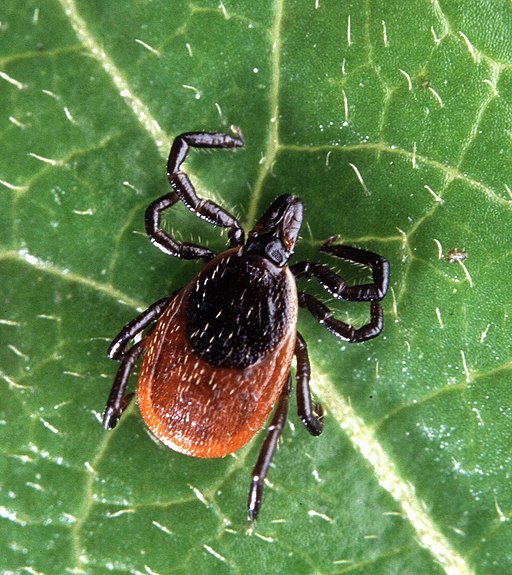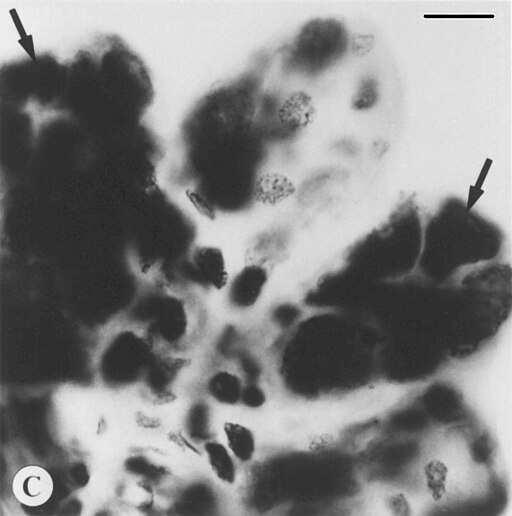[vc_row][vc_column][vc_column_text]
The Deer Tick

Deer tick. Photo by Scott Bauer. Public Domain.
Humans are known as “accidental hosts,” but the results of these tick bites are anything but mild. The deer tick can transmit a range of disease, such as Lyme disease.
HOW TO IDENTIFY DEER TICKS
Deer ticks can be distinguished from American dog ticks because they are usually about half their size. These ticks are brown but can also be red after feedings. They are roughly three to five millimeters long, but engorged females can be up to twice that size.
These ticks have flattened bodies and eight legs. Nymphs are about a millimeter long, also with eight legs, while larvae are about the size of a poppy seed and have only six legs.
Appearance, Behavior, and Signs
Deer ticks are most commonly found near wooded areas, especially those with large field mice and deer populations.
Deer can bring these ticks onto people’s lawns when they venture out of the woods and onto the lawns, making this species problematic in all areas, including residential.
These ticks are found all throughout the United States, but most commonly in the northeastern, mid-Atlantic, and southeastern portions of the country.[/vc_column_text][/vc_column][/vc_row][vc_row][vc_column][vc_column_text]
HOW DO YOU GET DEER TICKS
You might pick up a deer tick walking through an area with abundant populations of mammals, or through areas with brush or thick grass. Deer ticks are also more common in wooded areas with very little sun exposure and high levels of humidity.[/vc_column_text][/vc_column][/vc_row][vc_row][vc_column][vc_column_text]
HOW TO GET RID OF DEER TICKS
If you find a deer tick on your skin, remove it right away. The longer a tick remains attached to your skin, the more likely it is to transmit a nasty disease.
Don’t try to remove the pest with your fingernails. This is virtually impossible to do, and will likely cause the body of the tick to break off inside your skin. Ticks that have broken off inside of you are much more likely to cause disease.
To limit your likelihood of picking up a tick, wear long pants and sleeves, as well as close-toed shoes. Apply an insect repellent to your clothes and skin before venturing outdoors, and always inspect yourself immediately upon coming back inside.
If ticks are a problem in your particular area, make sure you keep your lawn mowed and all brush trimmed. Deer ticks are attracted to long grass, and walking through these areas makes you more likely to pick one up.
Finally, if you notice that deer tick populations on your property are increasing year after year, you may need to apply a general pesticide to permanently get rid of them.
Contact a licensed pest control professional who will walk you through the steps to preventing and treating tick infestations in this manner.
Deer Tick Facts

Deer tick virus. By Sam R. Telford III, Philip M. Armstrong, Paula Katavolos, Ivo Foppa, A. Sonia Olmeda Garcia, Mark L. Wilson, Andrew Spielman. Public domain.
These ticks can cause Lyme disease and Powassan virus, both of which can cause a range of serious symptoms.
While deer tick bites are usually painless, they are certainly not harmless. It can take victims weeks to realize they have been bitten, as no symptoms initially appear. Females can feed for long periods of time, giving them ample opportunity to cause illness or problematic symptoms.
If you think you may have found a deer tick on your or your pet, or if you think you have developed a serious infestation, search Exterminator Near Me for a specialist in your area immediately.[/vc_column_text][/vc_column][/vc_row][vc_row][vc_column][vc_separator][/vc_column][/vc_row][vc_row][vc_column][vc_column_text]
Tick Articles
[catlist name=”ticks”][/vc_column_text][/vc_column][/vc_row][vc_row][vc_column][vc_empty_space][/vc_column][/vc_row]